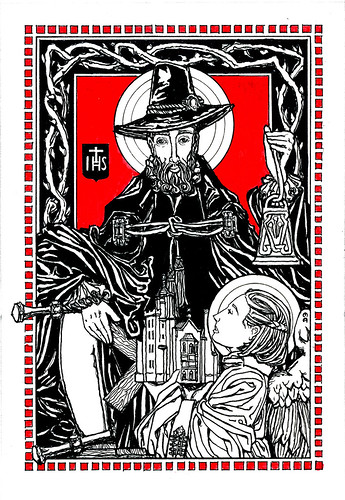Thursday, June 10
St. Margaret of Scotland and St. Nicholas Owen

Matthew Alderman. St. Margaret of Scotland. March 2010. Private Collection, Virginia.

Matthew Alderman. St. Nicholas Owen. March 2010. Private Collection, Virginia.
While her feast-day in the modern Roman calendar is much more familiar to me, today is the feast of the Hungarian-born Anglo-Saxon princess St. Margaret of Scotland in the old pre-1970 calendar, so-placed because of an oversold seating conflict with St. Gertrude the Great on her actual November 16 death-date. On account of this, I thought I'd share two recent drawings I did for a client and friend in Virginia, of the saint, and also of St. Nicholas Owen, the dwarf Jesuit carpenter responsible for the most impenetrable and complex priest-holes devised during the Elizabethan and Jacobean persecutions. I decided to borrow some elements from the late 19th and early 20th century "Glasgow School" design style popularized by Charles Rennie Mackintosh, and incorporate them in the drawing. This doesn't have too much to do with the symbolism (and indeed, it is not an explicitly religious style, though I know of at least one church built in this manner) but it is a local (if slight) nod to St. Margaret.
St. Margaret is usually shown with a book and a cross or crucifix, repeated here. I had to elaborate a bit further on her relatively limited iconography to flesh out the drawing; and while not truly a symbol of hers, she is often shown with her hair in plaits or braids like I have shown. The cross shows Christ the King, chosen as she was a queen, and the book has the arms of Scotland (the lion) and the cross of St. Andrew (Scotland's patron) on it. The brooch at her neck has the arms of Edward the Confessor, her uncle, on it. The flowers are a fairly generic representation of her feminine virtue and qualities, and there are some slight suggestions of Celtic knotwork in the border.
There is even less of an iconography for St. Nicholas though there are a few fixed points: lay clothing, lumber, and some sort of carpentry tools. The few images I saw of St. Nicholas show him in civilian clothes (with one rather anachronistic exception), hence the hat and ruff. I have added a large and vaguely clerical cloak to suggest in a loose way his status as a laybrother, though it is not meant by any means literally. It also suggests a bit of his mystery--as a Jesuit secret agent of sorts and patron saint of escape artists, he ought to have a little bit of dash to him. The little IHS is for his status as a Jesuit. The item in his left hand is the weight that was attached to his feet while he was tortured and eventually caused his chronic hernia to go critical and kill him. The three nails embossed on the weight are a reference to the Passion and also sometimes incorporated in the Jesuit monogram. In his left hand are a builder's square, stacked lumber, and a planing blade of some sort; I'm not sure what it's called but it's used to shave off excess wood. The angel is holding a model of the English manor where, I believe, he was finally arrested. One image I have seen shows him with a similar model, though I do not know if it is meant to represent all recusant houses or a specific one.
The relative proportions of red and black between the two images indicate that one was a martyr and the other not. The two were intended as a set, and the patron chose to use a reddish-brown wood for the frame, which nicely picks up on the red in the drawings.
I am currently planning out much of my summer and fall drawing and work schedule, so please feel free to contact me regarding future illustration commissions.












